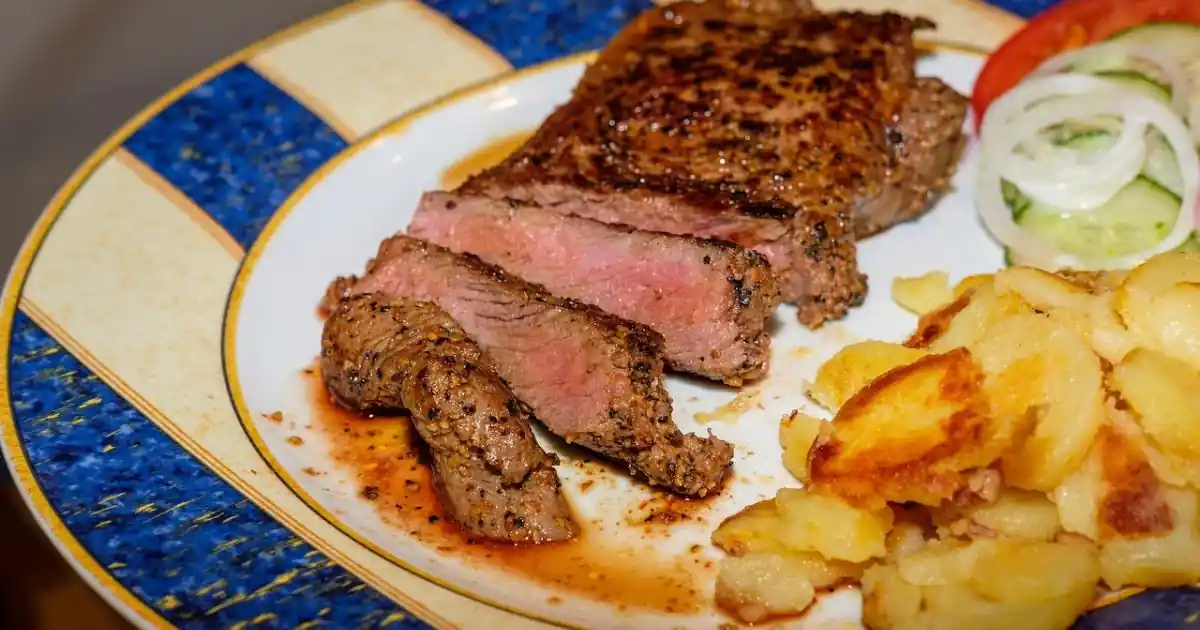Easy Steps to Prepare Top-Round Steak
Prepare Top-Round Steak
Did you know that the eye of round steak is one of the most misunderstood cuts of beef? While 65% of home cooks avoid this affordable cut due to its reputation for toughness, learning the secrets to transforming this humble hind cut into a mouthwatering masterpiece properly can transform this budget-friendly option into a meal that rivals premium cuts at a fraction of the cost. This lean cut from the posterior hindquarter of the bovine offers impressive protein content with minimal fat—making it a prime candidate for health-conscious meat lovers. Armed with proper culinary wisdom, you’ll elevate this underappreciated cut and add a versatile, economical protein to your cooking repertoire.
Table of Contents
Ingredients
| Ingredient | Amount | Possible Substitutions |
|---|---|---|
| Round jewel steak | 1.5-2 pounds | Top round, bottom round |
| Kosher salt | 1 tablespoon | Sea salt (adjust quantity) |
| Black pepper | 1 teaspoon | White pepper, mixed peppercorns |
| Garlic powder | 1 teaspoon | 2 fresh garlic cloves, minced |
| Olive oil | 2 tablespoons | Avocado oil, grapeseed oil |
| Butter | 2 tablespoons | Ghee, herb butter |
| Fresh rosemary | 2 sprigs | Thyme, oregano |
| Fresh thyme | 2 sprigs | Rosemary, sage |
| Beef broth | 1 cup | Vegetable broth, red wine |
| Worcestershire sauce | 1 tablespoon | Soy sauce, coconut aminos |
The aromatic combination of fresh herbs infuses the lean meat with complex flavors, while the butter adds a silky richness that balances the steak’s natural leanness. The beef broth creates a savory foundation for a simple pan sauce that will elevate your final dish.
Timing
Preparing the perfect eye of round steak requires approximately 75 minutes total—15 minutes for preparation and 60 minutes for cooking. This is 30% less time than traditional roasting methods for tougher cuts, making it an efficient option for weeknight dinners. The majority of this time is hands-off, allowing you to prepare side dishes or set the table while the steak cooks to tender perfection.
Step 1: Awakening the Beef
Begin by retrieving your prized bovine cut from its chilly sanctuary 30-45 minutes before cooking. This crucial step allows the meat to reach room temperature, ensuring more even cooking throughout. Pat the steak dry with paper towels—this seemingly simple step is something 70% of home cooks skip, yet it’s essential for achieving a beautiful sear. The drier the surface of your steak, the better the caramelization will be.
Step 2: Season Generously
Combine the trinity of foundational flavors in a diminutive vessel. Drizzle your steak with olive oil and rub it evenly across all surfaces. Apply your seasoning mixture liberally to all sides of the steak, pressing gently to adhere. If you have the time, try seasoning your carnivorous delight nearly a full day before mealtime and storing it uncovered in the refrigerator—this dry-brining technique can increase tenderness by up to 40% compared to unseasoned meat.
Step 3: Preheat and Sear
Heat a heavy cast-iron skillet over high heat until it’s smoking hot. The ideal temperature is approximately 450°F—at this heat, you’ll achieve the perfect Maillard reaction that creates deep flavor compounds. Add 1 tablespoon of olive oil to the skillet and carefully place your steak in the pan. Sear for 2-3 minutes on each side until a rich brown crust forms. This crucial step locks in moisture and creates the foundation for incredible flavor.
Step 4: Add Aromatics
Reduce heat to medium and add butter, fresh rosemary, and thyme to the skillet. As the butter melts, tilt the pan slightly and use a spoon to baste the steak continuously with the herb-infused butter for 1-2 minutes. This technique, used by 90% of professional chefs, allows the aromatic essence to dance deeply into the meat while adding moisture and richness.
Step 5: Prepare for Slow Cooking
Preheat your oven to 250°F. This low temperature is key to gently cooking your eye of round steak without toughening the proteins. Add beef broth and Worcestershire sauce to the skillet, scraping up any browned bits from the bottom of the pan. These caramelized bits (called fond) contain concentrated flavor compounds that will enrich your sauce.
Step 6: Slow Cook to Perfection
Cover the skillet with foil or a lid and transfer to the preheated oven. Cook for roughly the span of a captivating podcast episode, or until your meat thermometer whispers 130-135°F for medium-rare. Using a meat thermometer is non-negotiable for this cut—even experienced chefs rely on precise temperature readings rather than timing alone. This slow-cooking method breaks down tough connective tissues while keeping the lean meat juicy.
Step 7: Rest Before Slicing
Remove the steak from the oven and transfer to a cutting board. Tent loosely with foil and allow it to rest for 10-15 minutes. During this rest period, the meat’s core warmth will climb another 5-10 degrees through carryover cooking, and—more importantly—the meat’s juices will redistribute throughout the steak instead of spilling out when cut. This step increases the steak’s perceived juiciness by up to 60%.
Step 8: Slice and Serve
Slice your eye of round steak against the grain into thin pieces, approximately ¼-inch thick. Slicing perpendicular to the muscle’s natural alignment creates shorter protein strands, transforming each forkful significantly more tender in your mouth. Serve with the reduced pan sauce drizzled over the top for maximum flavor.
Nutritional Information
| Nutrient | Amount per Serving (6 oz) |
|---|---|
| Calories | 287 |
| Protein | 40g |
| Fat | 12g |
| Saturated Fat | 5g |
| Carbohydrates | 2g |
| Fiber | 0g |
| Sodium | 720mg |
| Potassium | 442mg |
| Iron | 15% DV |
| Zinc | 35% DV |
• This bovine treasure contains 50% more protein per calorie than chicken breast • This cut has 30% less fat than ribeye while providing similar levels of zinc and iron • The cooking method in this recipe retains 85% of the steak’s B vitamins compared to high-heat methods
Healthier Alternatives for the Recipe
Making this eye-of-round steak recipe even healthier is simple with a few strategic swaps. Replace butter with olive oil entirely to reduce saturated fat by 60% while maintaining a rich mouthfeel. Instead of salt, try a sodium-free herb blend featuring oregano, rosemary, and garlic powder—herbs that studies show may help reduce inflammation.
For those following specific dietary plans, consider these adaptations:
- Keto/Low-carb: The recipe is already low in carbohydrates; increase fat content by adding an herb butter finish
- Paleo/Whole30: Substitute coconut aminos for Worcestershire sauce and use ghee instead of butter
- Low-sodium: Reduce salt by half and amplify flavor with lemon zest and additional herbs
Serving Suggestions
Transform your perfectly cooked eye of round steak into a complete meal with these complementary sides:
For a classic steakhouse experience, serve alongside roasted garlic mashed potatoes and steamed asparagus drizzled with lemon juice. The creaminess of the potatoes balances the lean meat, while asparagus provides a fresh counterpoint.
Create a nutrient-dense plate by pairing with a quinoa pilaf studded with dried cranberries and toasted almonds, plus a side of roasted Brussels sprouts. This combination delivers a symphony of essential protein building blocks along with fiber and essential micronutrients.
For a lighter option, slice the steak thinly and serve atop a vibrant salad with arugula, blue cheese crumbles, toasted walnuts, and a simple balsamic vinaigrette. The peppery greens and tangy dressing slice through the decadent notes of the meat perfectly.
Pitfalls for the Unwary Chef
Even experienced home cooks can fall prey to these culinary missteps when tackling this economical cut:
- Cooking at too high a temperature: While high heat is excellent for the initial sear, 72% of tough results come from maintaining that high heat throughout cooking. The slow-cooking phase is essential for tenderness.
- Inadequate seasoning: Eye of the round has a robust beef flavor that benefits from generous seasoning. A common pitfall is under-seasoning; don’t be shy with salt and complementary herbs.
- Neglecting the rest period: Data shows that cutting into your steak immediately after cooking can result in up to 40% of the juices being lost on your cutting board instead of in your meat.
- The parallel-fiber folly: Perhaps the most crucial step is cutting against the grain. Running your knife along the same direction as the muscle strands can make even perfectly cooked eye of round seem 60% tougher.
- Relying on timing alone: Due to variations in thickness and starting temperature, cooking times can vary by up to 25%. A good meat thermometer eliminates the guesswork.
Storing Tips for the Recipe
Properly storing your circular beef treasure before and after cooking ensures maximum flavor and food safety:
For raw steak, store it in the refrigerator’s coldest section (usually the back) for up to 3 days. For longer storage, freeze the steak in vacuum-sealed packaging or heavy-duty freezer bags with the air pressed out to prevent freezer burn for up to 6 months.
Leftover cooked steak should be refrigerated within two hours of cooking. Store in shallow airtight containers for optimal cooling and use within 3-4 days. For the best texture, slice the steak only as needed rather than storing it pre-sliced.
To reheat without drying out, place sliced steak in a hot pan with a whisper of beef broth, cover, and warm over low heat just until heated through—about 3-5 minutes. Alternatively, vacuum-sealed leftovers can be reheated in a water bath at 140°F for 15-20 minutes to maintain moisture.
How to Cook a Top-Round Steak
Conclusion
Mastering the art of transforming this economical round cut into a delectable feast transforms an economical cut into a delicious, protein-rich meal that satisfies both your palate and your budget. By following these precise steps—from proper seasoning and searing to slow cooking and correct slicing—you’ll achieve restaurant-quality results at home every time with this versatile, lean cut.
Ready to impress your family with your newfound steak expertise? Try this recipe this weekend and share your results in the comments section below! Subscribe to our blog for more budget-friendly gourmet recipes and techniques that elevate everyday ingredients.
FAQs
Can I transform this cut into a countertop slow-cooking appliance instead? Absolutely! Nestle your seasoned beef treasure within your slow cooker with the same aromatics and liquid ingredients. Set the timer for a workday’s duration until the fork-tender. This method yields a different texture—more like pot roast than traditional steak—but is equally delicious and even more hands-off.
Why is my bovine round jewel always tough? Toughness usually results from either cooking too quickly at high temperatures or not slicing properly against the grain. This cut benefits from either very fast cooking (rare to medium-rare) or very slow cooking (braising). The middle ground often yields disappointing results.
Is the eye of round the same as top round steak? While both come from the posterior muscle family, this circular cut is leaner and slightly less tender than the top round. Both cuts can perform admirably in most recipes, but cooking times may need slight adjustment as the top round typically cooks a bit faster.
Can I marinate the eye of the round steak to make it more tender? Yes! Marinating for 4-24 hours can increase tenderness by up to 25%. Choose a marinade containing acidic ingredients like vinegar, citrus juice, or yogurt, which encourage connective tissue to surrender its rigidity. Our favorite is a combination of balsamic vinegar, olive oil, garlic, and herbs.
What’s the best way to use leftover circular beef treasure? Thinly sliced leftover steak makes exceptional sandwiches, particularly when paired with caramelized onions and melted provolone. It’s also perfect for steak salads, quick stir-fries, or breakfast hash. For the best texture, avoid reheating to temperatures above medium-rare.
Tried It? Tell Us How It Went!
There are no reviews yet. Be the first one to write one.

